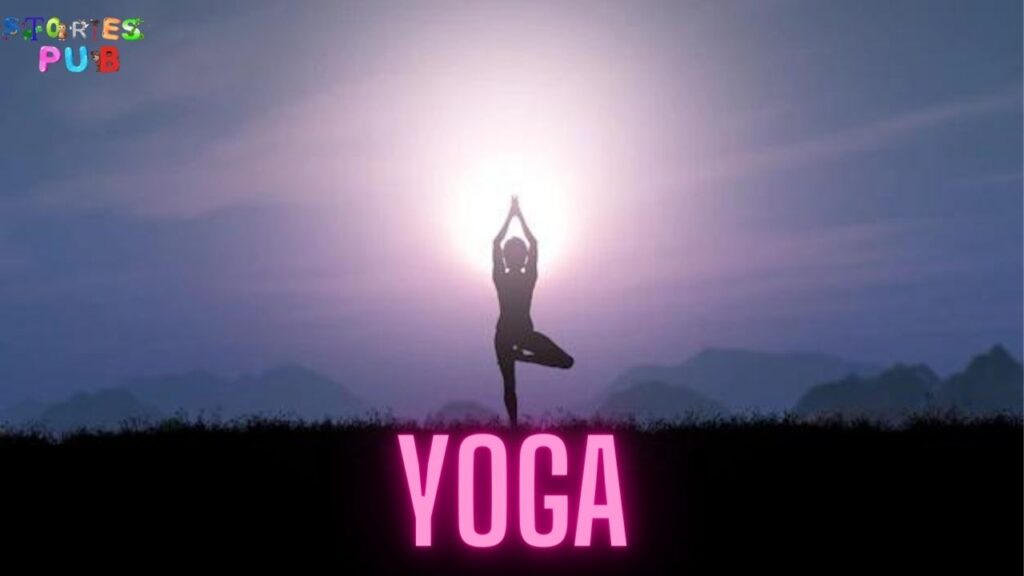Yoga – The Origins, Benefits, And Importance Of Yoga

Yoga is a spiritual practice and exercise that has existed since at least 5,000 BC. It is also a form of physical fitness. Today, it’s becoming more popular than ever among people of all ages. Yoga classes are offered at almost every major gym in the world, and even yoga videos are available on YouTube.
Many people have never tried this ancient activity and do not really understand what yoga is about. This article discusses some of the history and benefits of yoga to better educate you on what this wonderful exercise entails.
We will also discuss the origins and benefits of yoga and its importance in our lives; we will also discuss the different types of yoga, then a breakdown of the different kinds of asanas. After that, it discusses the difference between yoga and meditation and everything you’d ever want to know about this widespread practice.
Introduction
Hindustudents
Yoga is one of the oldest and most popular forms of exercise out there. It originated in India over 4,000 years ago, and it has been used as a way to improve health and well-being for centuries.
Yoga has been linked with some pretty impressive benefits, including reducing stress levels, improving your flexibility and balance, and even improving your memory. So why is yoga so important? Here are three reasons:
1. It Can Help Reduce Stress Levels
One of the primary benefits of yoga is that it can help reduce stress levels. According to studies, yoga can be a very effective way to reduce anxiety and tension headaches. In addition, it has been shown to improve your overall mood and ability to focus. So if you’re dealing with lots of stress in your life, yoga could be a great way to help you relax and enjoy your life more.
2. It Can Improve Your Flexibility and Balance.
Another benefit of yoga is that it can improve your flexibility and balance. According to some studies, yoga asanas (the poses) can help increase the range of motion in different joints, leading to improved flexibility and balance. This means you’ll be less icky and unsafe, which is always a plus.
3. It Can Help You Decrease Your Risk Of Disease And Illness.
Yoga can help you improve your overall health in many ways. For example, yoga has been shown to decrease your risk of cardiovascular disease and diabetes by helping you control your blood sugar levels and lose weight. It also helps build muscle mass, which can help you reduce your risk of injury and improve your overall ability to function well.
4. Yoga Can Boost Energy Levels
You may be surprised to learn that one of the most important benefits of yoga is how it boosts energy levels for all ages! One study showed that practising hatha yoga for 1 hour per week could increase energy levels substantially without any negative side.
The History and Origin of Yoga
Yoga is one of the oldest practices in the world and has a long history. The origins and benefits of yoga are vast. The word “yoga” comes from the Sanskrit word “yuj”, which means connecting or uniting. It is believed that yoga began in India more than 5,000 years ago.
Yoga is said to be beneficial for both the body and the mind and has been known to improve physical health, mental well-being, and spiritual growth. There are many different types of yoga, including Hatha, Iyengar, Kundalini, and Ashtanga.
Benefits of Yoga
Yoga is one of the oldest and most popular practices in the world. It has been used for centuries to help people stay healthy and relaxed, and it has even been linked to some benefits for mental health. Here are four of the most notable benefits of yoga:
-Yoga can help improve flexibility, balance, and strength.
-It can also help you manage stress and anxiety.
-It can improve your breathing and circulation.
-It can lead to a decreased sense of pain.
While yoga isn’t a cure for all your health problems, it can help you improve many parts of your life.
This is the perfect time to improve your life, and regular yoga would be an excellent choice. Yoga has been used for centuries for a variety of reasons. It helps with balance, flexibility, and the ability to focus without distraction. It also improves breathing which can alleviate stress and pain commonly associated with it.
Types of Yoga
There are many types of yoga, which can be broken down into three main categories: Hatha, Iyengar, and Vinyasa.
Hatha yoga is the most common type of yoga and is focused on physical poses and breathing exercises. It is often recommended for people who want to improve their flexibility and strength.
Iyengar yoga focuses on improving posture and flows through sequences of postures held for a specific length of time. This type of yoga is often recommended for people who want to improve their focus and concentration.
Vinyasa yoga is a more flowing form of yoga that combines both physical poses and breathwork. It is known for its energizing effects and is often recommended for people who want to increase their flexibility, balance, and stamina.
What’s the Difference Between Hatha Yoga, Power Yoga and Vinyasa?
Hatha yoga is often recommended for people who want to improve their flexibility, balance, and stamina. This kind of yoga is focused on physical poses and breathing exercises. It is often recommended for people who want to improve their flexibility and strength. Iyengar yoga focuses on improving posture and flows through sequences of postures held for a specific length of time.
This type of yoga is often recommended for people who want to improve their focus and concentration. Vinyasa yoga is a more flowing form of yoga that combines both physical poses and breath work. It is known for its energizing effects and is often recommended for people who want to increase flexibility.
All these forms of yoga are great and will give you the benefits you want, depending on what is important to you.
How to practice Yoga?
The practice of yoga has become popular in recent years, with many people finding it a relaxing and beneficial way to spend their time. There are many different styles of yoga, some of which are more vigorous than others, but all of them can help improve your flexibility, strength and balance. If you’re interested in practising yoga but don’t know how to start, here are some tips on how to get started:
1. Make sure that you have the right equipment. Some people find that they’re more successful when using yoga mats and straps, while others find that they’re just as successful without them. If you use mats and straps, make sure they are comfortable and sized correctly for you.
2. Choose a yoga style that suits your lifestyle and physical abilities. There are many different styles of yoga available, each with its own benefits. If you’re new to the practice, it’s essential to choose a manner that is easy for you to follow and that allows you to focus on your breathing and relaxation techniques.
3. Try out different poses until you find ones that work best for you. Once you’ve selected a pose or series of poses you enjoy, commit to practising it 3x week, or at least five times a week. You can also incorporate yoga into your daily routine if you like and choose to do it before or after work first thing in the morning. Or choose a time when you have more free time so that you’ll be able to devote more attention to your practice.
4. Keep any injuries and medical conditions that may prevent you from practising yoga under control. Remember, injuries, and medical conditions don’t have to get in the way of your yoga practice! If you are experiencing pain in your knees during certain poses or when bending over, then make sure you use padding (mats), straps, and extra support such as bolsters to help ease the discomfort.
5. If you are practising yoga for the first time, it’s essential to build up your confidence level. Start slow and work with a friend familiar with the basics of yoga to help you feel comfortable and confident as you try to form new poses. If you have any questions about what you’re doing or how it feels, don’t hesitate to ask your teacher!
6. Incorporate a variety of different types of yoga into your practice. This will help keep your mind fresh and provide many benefits to your body. For example, if you only do one type of yoga and then decide later that it isn’t right for you or isn’t working for you anymore, then it’s easy to get stuck in a yoga rut.
I highly recommend you try different types of yoga to see which one you are most drawn to, what poses flow best for you, and what helps your practice the most. The more varieties of yoga you practice and the more variety in your yoga practice, the longer it will take before it feels like you’re doing the same thing repeatedly.
Different types of Asanas and what they do
Today, yoga is widely practised worldwide for its many health benefits.
In this essay, we will discuss different types of Asanas and what they do.
The asanas (आसन) are the postures or poses in traditional yoga. There are dozens of asanas, each with its own set of benefits. The asanas help to improve your flexibility, strength, balance, and coordination, and they also help to decrease stress and tension in your body. Additionally, asanas have a wide range of effects on your mind and emotions.
Here are the many different types of Asana:
1) Poses that open up the chest and lungs:
-Breathwork Asana (Pranayama Asana): This pose involves breathing exercises that help to open the chest and lungs. It is recommended for people with asthma or COPD.
-Upward Facing Dog (Urdhva Muk āsana): This pose helps to open up your neck and shoulders, and it is also helpful for people who experience headaches or chronic pain in the back, neck and head.
2) Poses that stretch the front of your body:
Half Lord of the Fishes (Hal āhala āsana): This pose stretches the outer part of your arms and shoulders. -Eka Pada Kapotasana (Eka pada kapotasana): This pose helps stretch your hamstrings, hip flexors, and inner thighs.
3) pose that strengthens the legs:
Upward Facing Dog (Urdhva Muk āsana): This pose strengthens your core, spinal alignment, and hip flexors.
4) Pose that strengthens your back:
Downward Facing Dog (Adho Muk āsana): This pose strengthens your core and is also helpful for opening up your shoulder blades.
5) pose that stretches the lower back:
Bound Angle Pose (Baddha Konasana): This pose stretches the lower part of your back and can be an excellent overall stretch for the upper part of your body.
6) pose that lengthens the spine:
Supta Baddha Konasana (Supta baddha konasana): This pose is similar to the bound angle but works more deeply into your core. You should feel your hips, shoulders, and head opening as you move into this pose.
7) Poses that strengthen your core:
Adho Muk āsana (downward-facing dog): This pose will strengthen your core and help stabilize your body.
Pose Variations
In addition to specific poses, there are also a variety of variations you can do with these poses to open up more or change the intensity of each. For example, you can try bound bird (variation) or hang down dog instead of the bound angle. Here are some other variations for each pose: Side Angle Pose (Anjaneyasana) – Move the knee closest to the wall out to the side until it reaches a comfortable point. Try this on both sides before you leave āsana.
Benefits: This pose will strengthen your legs, shoulders, and abdominals, and it is also great for toning the arms and core.
Mountain Pose (Tadasana) – Try lowering yourself onto your hands or forearms instead of stepping down into a full āsana. For an inversion, try doing this without hands or forearms on the ground, with your knees bent or straight out, depending on what you think works best for you. You can also try a variation in which you use one hand to help push you up into position instead of stepping down.
Benefits: This pose will help open up your shoulders, chest, and lower back while strengthening your arms and abdominals.
What is meditation? What is the difference between meditation and yoga?
Meditation is a form of relaxation and concentration, and it can be practised in any location, at any time of day or night, and without any physical activity. The difference between meditation and yoga is that yoga is a physical exercise that helps you control your body and mind.
Conclusion
Yoga has been practised for centuries and is said to have originated in India. In recent years, it has become increasingly popular to improve one’s overall health and well-being. Yoga can help reduce stress, boost your physical fitness, and ease tension in the body. Additionally, yoga is beneficial for mental health, improving cognitive function and reducing anxiety. As such, if you are looking for a form of exercise that is both physically and mentally rewarding, yoga may be the right choice for you.
Thanks For Reading… Essay On Yoga
Hey kids, how much did you like Essay On Yoga – The Origins, Benefits, And Importance Of Yoga? Please share your view in the comment box. Also, please share this story with your friends on social media so they can also enjoy it, and for more such stories, please bookmark storiespub.com.
Suggested Article –
- An Essay on Diwali | Deepawali the Festival of Lights
- 1000 word essay on Mahatma Gandhi in English
- Essay on Environment for the Students in English
- Air Pollution Essay for the Students
- Essay on Child Labor for Students and Children
- Essay on My School for Students
- Essay on Newspaper
- Tree Essay for Students and Children
- Essay on Elephant for Students and Children in English?
- Essay on My Mother and why is she so Important



















